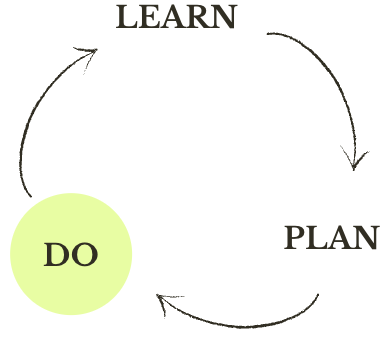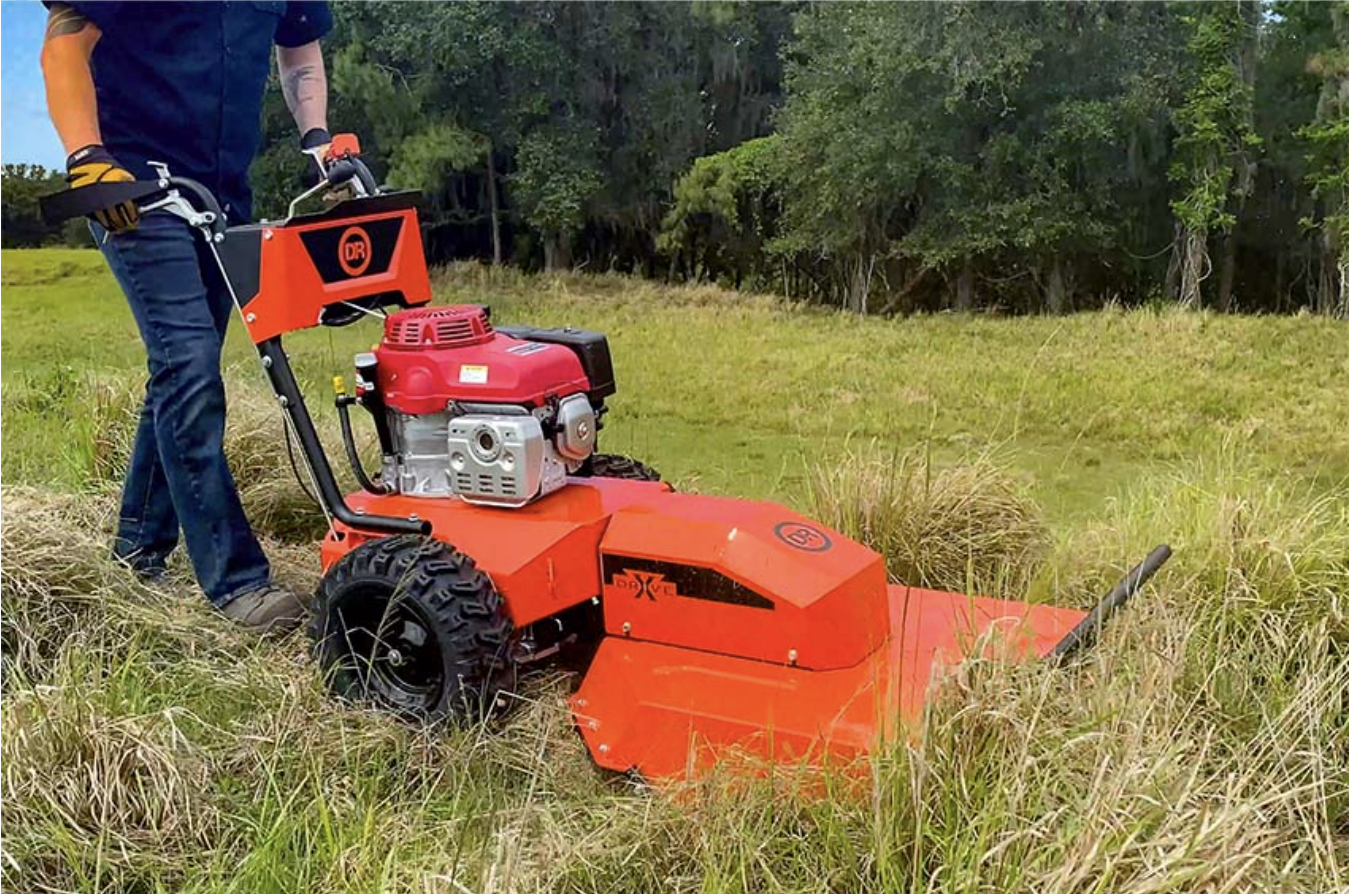DO THE WORK
Mowing
Mowing involves cutting grasses or brush over a broad area to a height that achieves the desired benefits.


Photo: DR Power Equipment.
Results and Benefits
Mowing can:
- Reduce wildfire risk by removing light, flashy fuels
- Allow safer travel along roads for firefighters and the public
- Reduce woody species encroachment into grassy areas
- Decrease competition from invasive grasses and plants, allowing native grassland species space to grow
When & Where to Mow
Situations that are appropriate for mowing include:
- When and where it is necessary to remove fuels before fire season
- To reduce the reproductive capacity of invasive grassland species before they produce viable seed (generally March – June)
- In the defensible space surrounding structures, along roadways, and in Shaded Fuel Breaks
Caution: Cutting during the dry season poses a severe fire risk. Unfortunately, every year mowers and the trailers that transport mowers are the source ignition points for wildfires.
Key Points Before Proceeding
Proper timing and height of mowing is necessary to create the desired results. Training or guidance from a professional restorationist, ecologist or land management/natural resource advisor is recommended. Many agricultural or forestry suppliers will also have specialized knowledge about proper tool selection to achieve a specific management goal.
Mowing incorrectly can spread invasive plants and degrade native grasslands. For example, mowing invasive grasses after they have created viable seeds spreads the seeds more widely. Seeds stuck to the mower can be transported to other areas and once established, become a new source of invasive seeds.
Learn more about Managing Invasive Species so you can time your mowing for maximum impact with less work. Common Sonoma County invasive grasses are cheatgrass (in drier hotter places, first usually in disturbed soil), red brome, ripgut brome, Harding grass, medusahead, and barbed goatgrass.
Most native California grasses are perennial (long-lived) and store large amounts of carbon. Supporting their growth and health, and removing competing invasive grasses, is one way to remove carbon from the atmosphere and fight climate change. Globally, grasslands store about 34% of terrestrial carbon, compared to 39% for forests.
How to Mow
Make sure you do not start a fire!
- Mow in cool weather.
- Cut early in the morning; CAL FIRE recommends before 10:00am.
- Avoid metal blades or cutting heads from contacting rocks; don’t cut in rocky areas or too close to the ground, especially when it is dry.
- Ensure chains from trucks and trailers do not hang low and contact the ground. Dragging chains during towing can cause sparks.
- Always keep water or a water-based extinguisher at hand when mowing.
Grasses can be mowed to different heights depending on the desired results. Mowing shorter than four inches can cause soil erosion, especially if bare dirt is exposed. On the other hand, mowing undesirable grasses very short or to bare ground can help kill them.
In grassy areas, walk through the grass before you mow to locate and avoid any nesting birds. See Nesting Bird Surveys for more information.
Blade Selection
Mowers can be outfitted with different types of blades to cut, or mulch, and manage grasses or brush. Choosing the right blade for the job can increase work efficiencies, effectiveness of treatment, and ease on the operator.
- Light grass is best mowed with a string-trimmer head.
- Blackberries, small diameter broom, and other small diameter shrubby material is best mowed with a tri-blade or U-shaped mulching blade.
- Thicker diameter woody material, such as larger broom or coyote brush, can be mowed with a radial saw blade sometimes referred to as a brush blade.
Take the time to plan the operation to maximize use of one type of blade before converting to the next.
Avoid spreading invasive seeds by cleaning your mowing equipment after each use.
Types Equipment for Mowing
Flail Mower: A heavy duty mower often attached behind lawn tractors or larger vehicles. Flail mowers are often used in areas with mixed small brush (i.e. blackberry or coyote brush) as they can cut and shred woody material. Flail mowers are typically used in large areas or agricultural settings. Flail mowers create a more significant impact on the vegetation and soil. These impacts should be strongly considered before proceeding. Tractors can cause soil compaction if used when soil is saturated. Attention to site conditions is critical when using large equipment.
Brush Cutter (also called weed whacker or line trimmer): This is the best tool for difficult-to-access areas or tall plants that cannot be easily mown down in a single pass. They range from light to heavy duty, and include the heads detailed above. Avoid fatigue and injuries by using a harness which puts the weight on the hips rather than the back.
Walk-behind high weed mower: Appropriate for grasslands with uneven ground or tall grass. These mowers work well in natural grasslands surrounding structures such as barns, and along roadsides.
Riding lawn mower: Good for large, even-leveled grasslands. Generally not ideal for use with grasses over 10”, in undeveloped or steep terrain, or for thin annual grasses.
Variations on this Practice
- Different grass heights can be considered.
- Small islands of native grasses or shrubs can be left to create a mosaic of habitats to bolster biodiversity.
- Consider combining mowing with other techniques for better results.
For managing invasives:
- For small invasions combine mowing with thinning or hand-pulling.
- For large invasions, you can use highly targeted herbicide or grazing to reduce the invasive volume.
- When promoting biodiversity in a grassland or open woodland, alternating each year between Beneficial Fire and Mowing can reduce invasives and may be the gold standard for stewardship.
Timing Considerations
Generally, mowing in late spring to early summer is recommended when soil moisture is decreasing and regrowth is less likely. To control non-native grasses, mowing should be done when the grasses are in their growing phase and before they create viable seed, generally April – June. This can be used as an effective management technique for invasive species, although they will often need follow-up treatments.
Bird nesting season in Sonoma County runs from March through August, often the best timeframe for mowing. If you are mowing within this timeframe, review Nesting Bird Surveys. Carefully walk the areas you plan to mow to ensure there are no ground nesting birds. If you locate a nest, create a minimum of a 100-foot buffer around the nest and do not mow in or disturb that area.
Pay attention to native wildflowers and the non-grasses collectively called “forbs.” You can strengthen the native seed bank and support biodiversity if you wait to mow these plants until they have sown their seeds.
Mowing or brush cutting often requires multiple passes. For example, for non-native species like Himalayan blackberry or French broom, a single pass provides only temporary control. Multiple passes help exhaust the nutrient stores of the plants.
Equipment
Personal Protective Equipment
- Long pants
- Long-sleeve shirt
- Sunscreen
- Boots
- Helmet with mesh visor
- Eye protection
- Ear protection
- Leather gloves
Tools
Water-based fire extinguisher or water in case of accidental fire
Maintenance
Grasses should be mown at least once each year, before fire season. Several more passes may be necessary if:
- You are managing invasive species such as medusahead, yellow starthistle, or Harding grass
- Native flowers or grasses are seeding in the area and mowing cannot be completed all at once
Related Practices
Managing Woody Species Encroachment
Please note: this is a general guide. The specifics of how and when to do this practice will depend on many factors, including the site’s particular vegetation, climate and topography, history, and land management goals. Always consult with a professional if you’re unsure.
Do you have your principles in mind? Remember to regularly check in with your land management goals, to assure your practices and actions will actually achieve them.
Additional Resources
WeedCUT: Mowing with large equipment
WeedCUT: Using Brush or string trimmers
WeedCUT decision matrix
The California Native Grass Association is a great resource and offers workshops on grass identification


